Connecticut
The Mattatuck Museum has been selected as a 2022 finalist for a National Medal for Museum and Library Service by the Institute of Museum and Library Services! This award is the nation’s highest federal honor given to museums and libraries for service to their communities. National Medal winners will be announced the first week of June, and a national ceremony and celebration will be held in July.
The Bruce Museum recently announces the promised gift of a major collection of European and American art—ranging from French and American Impressionism to the works of Winslow Homer, Edward Hopper, Alberto Giacometti, Henry Moore, Andrew Wyeth, and others—which will come as a bequest from an anonymous Greenwich couple. The private collection of 70 works, encompassing paintings, sculpture, watercolors, drawings, prints, and photographs, will be the largest gift of art in the Bruce Museum’s 112-year history. Coming at a transformative moment for the Bruce Museum, the announcement of the promised collection accompanies a substantial leadership grant the donors have made to the New Bruce building campaign. The $60 million renovation and expansion project will double the size of the existing building and create new, modern, and spacious galleries for exhibitions and installations, as well as state-of-the art spaces for education and community events. The New Bruce is scheduled to open in March 2023, with the addition of more than 12,000 square feet of gallery space in the William L. Richter Art Wing, including a 4,500-square-foot gallery for changing exhibitions and five new galleries for the growing permanent art collection.
The Prudence Crandall Museum recently completed a $1.6 million, two-year restoration process. The restoration included structural work, a new HVAC system, new fire detection, electrical work, new ADA ramp, new roof, and exterior painting.
The Slater Memorial Museum at Norwich Free Academy has been closed since the new year to accommodate its roof restoration project, which is expected to be finished in November. The museum's roof is the original, from when the building was first built in 1886. While there is no immediate threat of roof damage, Norwich Free Academy has been working on maintaining the roof for some time now, as the school received a $10,000 grant from the state back in 2015. Now, Rugh said the project, costing $1.8 million, is paid for with funds from the Norwich Free Academy Foundation, grants, and other sources the school is seeking.
NASA has selected Mystic Seaport Museum as one of a diverse group of Museums, science centers, libraries, and other informal education organizations from around the country designated as a NASA Informal Education Community Anchor. The designation recognizes the Museum and its Treworgy Planetarium as a community resource and provides a $24,266 grant to bring space exploration to traditionally underserved areas and broaden student participation in the fields of science, technology, engineering, and math (STEM). The Museum will address the local needs of middle school students in Eastern and Southern Connecticut by using and sharing NASA STEM engagement learning resources and opportunities. Mystic Seaport Museum is one of only 21 recipients selected from across the United States. It is one of only two Community Anchors in New England. The new programs will be rolled out in fall 2022.
Congratulations to the following NEMA members that have received a recent CT Humanities grant:
Quick Grants:
- Lyman Allyn Art Museum: $4,530, A Celebration of Black Poets of Connecticut
- New Britain Museum of American Art: $4,993, The Poetry of Nature at the NBMAA,
- Yellow Farmhouse Education Center: $1,731, Food & Gender Virtual Author Series
Capacity Grants:
- Mystic Seaport Museum: $9,999, DEAI: External Process & Critical Issues Report
- Project Planning and Implementation Grant recipients:
- Cornwall Historical Society: $11,386, Finding Freeman(s): Freedom, Property, and Identity in Cornwall
- Florence Griswold Museum: $35,000, New London County Quilts and Bed Covers, 1750–1825
CTH SHARP Capacity Grants:
- American Clock & Watch Museum: $9,000, IT Consulting and Support
- Blue Slope Country Museum: $5,300, History of Farming for ESL/ELL
- Cheshire Historical Society: $10,000, Strategic Plan Implementation Work: Collections Assessment
- Connecticut Historical Society: $10,000, IDEA Consultant Services for Assessment, Planning and Training
- Connecticut Landmarks: $10,000, 21st Century Historic Houses - Technology Implementation
- Denison Pequotsepos Nature Center: $10,000, Dynamic Website Project
- Designing a New Museum
- Greenwich Historical Society: $10,000, Strategic Planning
- Hill-Stead Museum: $10,000, Diversity, Equity, and Inclusion Training
- Institute for American Indian Studies: $9,951, Enabling Access to Native American Cultures
- Keeler Tavern Museum & History Center: $10,000, Board Development
- Litchfield Historical Society: $10,000, Archival Description Project: Photographs, Ephemera, & More
- Museum of Darien: $10,000, Collection Inventory Catalog
- Mystic Seaport Museum: $10,000, DEAI Training across All Departments
- New Britain Institute/New Britain Industrial Museum: $10,000
- New England Air Museum: $10,000, Expanding Our Digital and Virtual Outreach
- New London County Historical Society: $10,000, Development Director
- Norwalk Historical Society: $10,000, Virtual Community Exhibitions
- Stonington Historical Society: $10,000, Plan for Inclusive Exhibits/Lighthouse Museum
- The Dudley Farm Museum: $10,000, Exhibit Planning for the Quinnipiac Dawnland Collection
- The Mary & Eliza Freeman Center for History and Community: $10,000, Digital Capabilities Upgrade
- Wadsworth Atheneum Museum of Art: $10,000, Strategic Planning Project
- Webb-Deane-Stevens Museum:, $5,740, Improving Online Presence
- Wethersfield Historical Society: $10,000, Database of Free and Enslaved People of Color in Wethersfield, 17th through 19th centuries.
Massachusetts
Discovery Museum has announced a $75,000 grant from Yawkey Foundation to launch the museum’s work to translate a significant number of educational and access materials across its school and family programs into multiple languages, to better welcome and serve a diverse audience. Materials to be translated include pre- and post-workshop student activity guides for the museum’s in-school STEM programs; museum exhibit guides, sensory guides for children with special needs, field trip chaperone materials, and at-home STEAM activity resources for families. Different content pieces will be translated into languages most impactful for their reach, including Haitian Creole, Khmer, Portuguese, Arabic, Russian, Hindi, Spanish, Vietnamese, and Chinese (Traditional). The Museum’s website, already equipped with Google Translate functionality, is being enhanced to allow visitors to select their desired language for downloadable materials.
In 2021, the Fitchburg Historical Society received a multiyear grant for support of its childhood and community educational programs from the George R. Wallace Jr. and Alice Wallace Foundation. The Wallaces were residents of Fitchburg with deep roots in the community and the foundation is committed to the cultural development of the City of Fitchburg through innovation in its educational and cultural institutions. The Fitchburg Historical Society’s new series of specials on local history were sponsored by the Mass Humanities Bridge Sponsorships. In 2021, three new one hour specials were created on: Mid-century Modernist architecture in Fitchburg by Carl Koch; Uruguay and the 1950 World Cup Championships (presented in Spanish), and Abolitionist Park and the Abolitionist Movement in Fitchburg. All were broadcast on Fitchburg Access TV and are also available with Video on Demand.
The Harvard Art Museums announce a transformative gift of 21 works of 18th-century American silver from the collection of Daniel A. Pollack and Susan F. Pollack. The gift comprises a range of finely made vessels and table implements intended for domestic use, including cups, bowls, spoons, tankards, and teapots crafted by noted silversmiths from Boston, New York, Philadelphia, and Trenton. There is also a stunning caudle cup, an example of ecclesiastical silver made by Edward Winslow and believed to have been used during communion at First Congregational Church in Milford, CT. The Pollacks’ gift strengthens the museums’ noted holdings of 17th- to 20th-century silver and comes at a time when curators and postdoctoral fellows are working to reimagine the balance among paintings, sculptures, and design objects on view in the galleries.

Following a multi-year project led by members of the Fuller Craft Museum staff, board of directors, and under the direction of Board Chair, Annie Rosen (she/her), Fuller Craft Museum unveils a new visual identity— including a bold new logo, color palette, typeface, and all-around look-and feel for the Brockton-based museum. "We're extremely excited about the launch of our new brand identity and what it will do for Fuller Craft Museum, which has long been a mainstay of Massachusetts's cultural landscape," said Executive Director Erin McGough (she/her). "Our bright new red, blue, and yellow color palette will help our marketing materials stand out, even here on site - where the museum is nestled in its leafy, pondside location. Our new font is vivid, energetic and inviting - in keeping with our museum, the vision of our artist-makers and their materials, and like the Brockton community itself, of which we are a very proud part." The museum’s new logo is comprised of three abstracted letterforms—inspired by curated objects coming together—which come together to create a range of vibrant patterns. The Museum’s new typeface, Cadíz, was designed by Luzi Gantenbein (he/him) of the Swiss type foundry, Luzi Type. An elegant, warm, and highly legible sans serif typeface, it was inspired by a film-setting font from the 1960s. The full range of its design applications is being led by Caitlin Burton (she/her), Fuller Craft’s Graphic Design and Social Media Manager.
The Peabody Essex Museum (PEM) announced that longtime museum supporters, Elizabeth and Stuart Pratt will endow the museum’s position of Curator of Native American and Oceanic Art and Culture. Since its founding in 1799, PEM has collected Native American art, and today this collection stands among the oldest in the western hemisphere, widely recognized for its outstanding quality, range of time, media and geography; provenance, and condition. PEM’s Oceanic collection spans the 18th century through the present and features important works representing more than 36 Pacific island groups, including a rare temple image of the Native Hawaiian akau (deity) Kū who occupies a place of honor in PEM’s new wing and draws visitors from around the world.
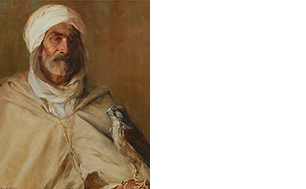
The Old Falconer of Ben Gana, Sheik of the Ziban (1906), by Elizabeth Rebecca Coffin
The Nantucket Historical Association (NHA) is pleased to announce the acquisition of the painting The Old Falconer of Ben Gana, Sheik of the Ziban (1906), by Elizabeth Rebecca Coffin, thanks to a generous gift from the Friends of the Nantucket Historical Association with additional support from members of the Friends’ Acquisition Committee. Elizabeth Rebecca Coffin (1850–1930) was an educator, philanthropist, and the most important female artist associated with Nantucket. Her signal achievement for Nantucket was the revival and transformation of the Coffin School, which she helped guide for more than two decades.
The Forbes House Museum is restoring the museum's 1833 carriage house and 1870's adjoining barn and is one of the museum's top priorities. The unique space with its character-defining historic features will one day be a wonderful resource for both the museum and greater community. In order to spread awareness and cultivate public and private support, the museum plans to use funding from the National Trust for Historic Preservation to develop a brochure and other materials highlighting the barn's and carriage house's architectural significance, as well as our plans for the space's adaptive reuse.
Lynn Museum/LynnArts will be celebrated its 125th anniversary on April 27th. It began as the Lynn Historical Society in 1897 and have since evolved into a vibrant cultural center in the heart of Lynn's arts and culture district.
The Marblehead Museum has recently purchased the brick building adjacent to its Jeremiah Lee Mansion (1768). Also completed in 1768, this building served as a detached kitchen for the house, as well as the living quarters for Lee's enslaved individuals. The museum has launched a multi-year project to study, preserve, and interpret the building.
The Samuel Slater Experience, a historic museum featuring state-of-the-art 4-D digital technology to tell the story of Samuel Slater, the beginnings of the American Industrial Revolution, and the founding of Webster, Massachusetts in the early 19th century, has officially opened for self-guided tours. The Samuel Slater Experience is made up of more than twenty unique, immersive exhibits that transport the audience back to the early 1800s as the seeds of the American Industrial Revolution were sown. The museum starts with a young and conflicted Samuel Slater and his immigration to America, his success during the era and his impact on the geographic area. Slater would move to the United States and build an empire of cotton mills in New England, including one in what was then called Oxford and later renamed Webster
The USS Constitution Museum ranks #5 in USA Today’s 2022 10Best Readers’ Choice travel awards in the category of “Best History Museum” for the second consecutive year! In a competitive category of top museums from around the United States, online votes determined the winners from 20 initial nominees. The museum was the sole nominee and winner in this category from Boston.
Thanks to a grant from Mass Humanities, the Public Health Museum will begin digitizing over 400 intake ledgers from Tewksbury State Hospital. The ledgers span from 1884 through the late 1940s. Ledgers predating 1884 were previously digitized through a collaboration with the University of Massachusetts Lowell Libraries and can be accessed online through the university’s website. Digitizing the remaining records will not only ensure the longevity and preservation of the ledgers, but will enable genealogists, researchers, and scholars to access the records to better understand the history of the state hospital and the many people who came through its doors. Using a CZUR ET18 Pro Professional Document Scanner, the records will be scanned, archived, and tagged with metadata (data that provides information about the document).
The Clark Art Institute recently acquired an extremely rare tea service that is noted both for the exceptional craftsmanship on the part of the woman artist who was central to its creation and for its subject matter, a remarkable collection of portraits of women noted in European history. The Tea Service of Famous Women (Cabaret des femmes célèbres) is now on view in the Clark’s permanent collection galleries. With miniature portraits painted by Marie-Victoire Jaquotot between 1811–12 for the Sèvres Porcelain Manufactory, the service is one of only three known sets and features portraits of women noted for their achievements within governance, literature, philosophy, and international relations.
Saugus Iron Works National Historic Site has started preservation and restoration work and going through midsummer. A contractor hired by the National Park Service will be replacing much of the charging bridge and casting shed roof of the blast furnace. This maintenance project will replace aging wooden beams, decking, and other elements to maintain and improve safety and condition of these structures. A substantial portion of the upper lawn and a perimeter around the blast furnace and casting shed will be fenced off for materials, equipment storage (including a large crane) and work area. The remaining unfenced lawn areas, entrances to the park and all other pathways through the park will remain open to the public unless construction activities require additional temporary closures to ensure safety. Work and access areas of the upper lawn will be protected with heavy landscape fabric and gravel placed on top of the turf to protect the lawn and archeological resources.
The Springfield Museum’s Science Museum has received a $750,000 federal earmark will primarily fund a project called “Equitable Access to the Night Sky.” This project will include a new, full-dome digital projection system and state-of-the-art software for the planetarium. As well as a full digitalization of the observatory for online observation and new multi-sensory astronomy exhibits.
The Emily Dickinson Museum has received a $600,000 pledge toward its goal of raising $3.5 million for major renovations and improvements. The gift from former museum board members John and Elizabeth Armstrong will be used for the design and reconstruction of the Carriage House that once stood to the east of The Evergreens. Reconstruction of the Carriage House is expected to be finished by early 2024. The building will initially serve as a welcome center for visitors while a separate restoration of the Dickinson Homestead is completed, the museum said. The Carriage House will eventually be used for learning and engagement. The museum is currently closed to the public while it completes the second phase of a three-part restoration project at the Homestead, the poet's birthplace and home. It is expected to reopen later this year.
The Cyrus Dallin Art Museum was awarded a $50,000 grant from the state's Office of Travel and Tourism to redesign its entryway and the Indigenous Peoples gallery, as well as digitize the museum's archives and build an online searchable database. The museum received an additional $5,000 Partnership Grant from Freedom's Way National Heritage Area to support the redesign. Museum staff are working with Indigenous stakeholders to ensure the spaces accurately represent the histories, cultures and resilience of those who were the subjects of Dallin's works, according to a statement from the museum. The project, which includes revised floor plans, new pedestals, refreshed paint finishes, colorful window graphics, interpretive panels, an audio program and an interactive display, will be designed by Somerville-based Proun Design. The museum's archives, which consist of more than 6,000 photographs, correspondences, sketches, journals, exhibition catalogs, news clippings and poems written by Dallin's wife Vittoria, will be digitized in partnership with Concord-based Museum & Collector Resource.
The Museum of Fine Arts, Boston has announced that work of art by a 17th century Dutch painter that was reported looted from a Hungarian bank during World War II is being returned to the heirs of its rightful owner. “View of Beverwijk" by Salomon van Ruysdael has been in the museum's collection since 1982, when it was acquired from a London dealer with no information about its history other than that it had come from a Swiss collection, the museum said in a statement.
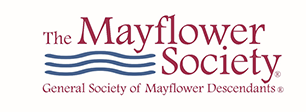
The General Society of Mayflower Descendants, more commonly known as the Mayflower Society, located in Plymouth, MA, is enjoying its 125th anniversary. Founded in 1897, it is home to 54 member societies and nearly 32,000 members. Additionally, The Mayflower Society is undergoing extensive renovation and restoration work on its 1754 Mayflower Society House (formerly known as the Winslow House), which it hopes to reopen by summer 2023. The Mayflower Society recently unveiled its new logo:
Over the summer and fall of 2021, the Rotch-Jones-Duff House & Garden Museum was repainted in the historic colors dating to its first owner, Willliam Rotch, Jr. Alexander Papo, owner of Architectural Conservation Services (Seekonk, MA) was hired to do a scientific paint analysis, scraping 28 samples from the exterior buildings and analyzing them in his lab before paint colors were chosen. A grant from the Community Preservation Act (CPA) covered the expenses of painting and repairs. The CPA is a Massachusetts state law designed to help towns and cities plan for sustainable growth and provide funds to achieve their community preservation goals.
The Charles River Museum reopened to the public on Wednesday, April 6, 2022 for the first time in nearly 25 months.
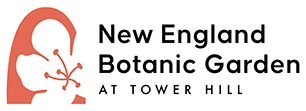
Tower Hill Botanic Garden, a Boylston nonprofit that traces its roots to 1840, which works to advance horticulture, announced it changed its name to New England Botanic Garden at Tower Hill to reflect its goal of “helping people all over New England make joyful connections with plants.”
The Cahoon Museum of American Art has acquired the historic Crocker homestead at 4698 Falmouth Road, adjacent to the museum site. The property is one of six original Crocker homes—including the museum—dating from the middle to late 18th century along the old stage road from Falmouth to Hyannis. The purchase of the 1.9-acre property comes complete with the original house, outbuildings and a landscaped garden. The museum will begin planning its next steps, which will include input from stakeholders and community leaders, over the next several months. Expanded facilities for educational programs, new galleries for exhibits, space for events and gatherings of museum friends and community groups, and a garden for reflection and refreshment are among the ideas museum leaders are hoping to explore.
The Cape Ann Museum has announced the acquisition of the Ralph Maud/Charles Olson Library from the Gloucester Writers Center. The collection, containing over 4,000 volumes, documents the reading and knowledge-building practices of Gloucester-based and renowned poet Charles Olson as well as the scholarly method of book collecting and bibliography by scholar and book collector Ralph Maud. The Maud/Olson Library will be housed in the Janet & William Ellery James Center at the Cape Ann Museum Green.
Congratulations to the following NEMA members that received a National Endowment for the Humanities grant:
Cape Ann Museum: Infrastructure and Capacity Building Challenge grant for the modernization and renovation to include improved climate control, lighting, visitor accessibility improvements, and an expanded gallery space.
Massachusetts Historical Society: Fellowship Programs grant for 18 months of stipend support (2 fellowships) per year for three years and a contribution to defray costs associated with the selection of fellows.
Northeast Document Conservation Center: Preservation Education and Training grant for a wide range of preservation and access activities, including addressing preservation emergencies through continuation of a 24/7 Collections Emergency Hotline and workshops on disaster planning and response, producing reference materials and updating the website, and building training webinars and online courses.
Maine
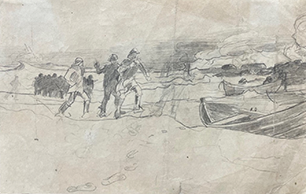
Winslow Homer, Untitled
The Ogunquit Museum of American Art has received a gift of a drawing by Winslow Homer, Untitled, referred to as “The Rescue Party.” This is the first drawing by the artist to enter the collection at OMAA. The work was donated by longtime supporters Helen and Michael Horn.
The Maine Central Model Railroad will be relocating to a new home at Seashore Trolley Museum, located in Kennebunkport, Maine in 2022, with thanks to a very generous donation from the Wyss Medical Foundation.

A rendering of Seashore Trolley Museum’s new Maine Central Model Railroad building designed by architect Herb Fremin
The Seashore Trolley Museum is working on two major building projects on its 350-acre campus. The first new building was announced in January 2022; a building to house the Maine Central Model Railroad, that is currently located in Jonesport. Now, thanks to a $1 million anonymous donation, the museum’s oldest trolley storage building, the Burton B. Shaw South Boston carhouse, will be replaced.
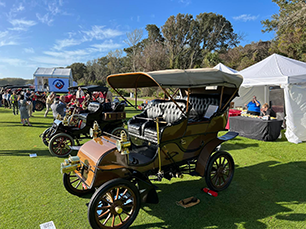
1904 Knox automobile
The Seal Cove Auto Museum’s 1904 Knox automobile was one of 215 “Historically significant vehicles,” celebrated at the Amelia Concours d’Elegance (The Amelia). This event is one of the most anticipated and high-profile events in the automotive world, drawing some 22,000 visitors, 350 media representatives and raising $200,000.00 for local charities. The Museum’s two-cylinder 18-20 HP Knox attracted attention from the moment it was unveiled at 7:30 a.m. on Sunday, March 6. The car drew particular notice from Diane Parker, vice President of the Hagerty Drivers Foundation, and as a result, the vehicle was awarded the “Hagerty National Automotive Heritage Award” in recognition of its historical significance and provenance.
New Hampshire
In 2016, when Squam Lakes Natural Science Center updated its Strategic Plan, an ambitious 50 by 30 pledge was made. The pledge was to achieve 50% of its energy consumption from renewable sources by 2030. The Science Center has taken several steps in that direction over the last five years but is ready to make a huge leap to surpass its goal with a new solar array currently under construction. The full project is a 139kW solar photovoltaic array (380+ panels), which will be constructed in two phases. The completed project is sized to generate enough power to offset nearly all of the Science Center’s electric needs. The PV project could save approximately $26,000 in electricity costs annually and over 250,000 pounds of CO2 emissions. It will be paired with educational interpretation to teach visitors about renewable energy and the climate crisis. Phase one of the $375,000 project commenced in November 2021. Approximately 20% of the project’s solar panels (totaling 24.82kW) are being installed on the roof of the Early Childhood Education Center – home of the Science Center’s Blue Heron School, a nature-based Montessori early learning center for students ages 3 to 6. The second phase is ground-mounted arrays to be placed around the main parking lots. Construction will begin when funding is in place – hopefully later this spring. Potential donors are encouraged to contact Iain MacLeod at iain.macleod@nhnature.org. The Science Center is grateful to funding already received from Hypertherm Hope Foundation – Green Grants, The Samuel P. Hunt Foundation, and Trustee Emily Preston and her brother Andrew Preston for funding received to date.
Rhode Island
On Thursday, January 20th at 2:30pm, State Representatives Steve Casey, Steve Lima, and Robert Phillips will join Museum of Work & Culture Director Anne Conway to present a $9,000 legislative grant that will assist in funding the museum’s new multimedia permanent exhibit, Flowing Through Time: Nature, Industry, and Communities of the Blackstone River. Flowing Through Time will allow the Museum to grow its educational impact by showcasing the importance of the Blackstone River over multiple centuries. The exhibit will focus on the function of the water power that made the mills possible, the communities that have lived with and been impacted by the river, and the long term ecological impact the industrial era had on the water and wildlife.
The Newport Historical Society recently completed a digitization project in partnership with UK-based publishers Adam Matthew, to scan materials for their e-textbook: The Gilded Age and Progressive Era. Over 16,000 images of our collections were captured, including the Newport Casino Bulletin (1899-1910), Newport Directories (1873-1900), Havemeyer photograph albums (1896-1925), and other object and manuscript materials from the turn of the 20th century. The NHS is pleased to have these materials digitized, as part of our ongoing mission to preserve our collections and facilitate research through our Academic Services.
Congratulations to the following NEMA members that received a The Rhode Island Council for the Humanities grant:
Little Compton Historical Society: The Secrets of Cellar Holes: Blending Public Archaeology and Local History in Little Compton
Funds support an in-person special exhibit and accompanying in-person and hybrid programming. The exhibit and programming focus on public archaeology investigating cellar holes that were historically part of homes belonging to local, free families of color.
Rhode Island Historical Society: Providence Commemorative Works Project: Phase 1
Funds support the compilation and back-end development of a comprehensive database of commemorative works in Providence.
Vermont
As part of Rokeby Museum’s vision to enhance the history of Vermont and explore an inclusive telling of the American story, the museum is launching a series of new education programs in 2022. Rokeby Museum connects visitors with the human experience of the Underground Railroad and the lives of the four generations of the Robinsons who lived at Rokeby from 1793 to 1961. The Robinson family’s story is diverse and the Museum shares the history of the Abolition movement, Vermont agriculture, and the art and literature careers of the Robinson family. In addition to the new summer program, Rokeby Museum received a private donation to expand its virtual tours. The continued growth of Rokeby Museum’s education initiatives is helping expand the reach of a significant National Landmark in Vermont.
The Saint Albans Museum has recently started work on a major revamp of its basement storage area, which holds the vast majority of its collections items. Consisting of thousands of items from hundreds of years of Saint Albans history, the SAM collection is a true testament to the generosity of the local community. However, in recent years, the museum has been challenged by a lack of storage space, making it increasingly difficult to accept new items.
After securing the funding through numerous grant applications, the Old Stone House Museum, will use the money to further educational opportunities for students. The museum has an array of different on-site, hands-on classes and workshops for students to learn more about Brownington and its history. Executive Director Molly Veysey says the funds will help to establish a curriculum in schools throughout the Northeast Kingdom.
The Bennington Museum recently received a National Endowment for the Humanities Infrastructure and Capacity Building Challenge Grant for the purchase and installation of energy-saving windows.